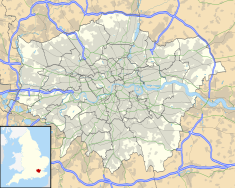| Aubrey House | |
|---|---|
 Aubrey House | |
| Location | Holland Park, West London, England |
| Coordinates | 51°30′20.87″N 0°12′9.32″W / 51.5057972°N 0.2025889°W |
| Built | 17th century |
Listed Building – Grade II* | |
| Official name | Aubrey House |
| Designated | 29 July 1949[1] |
| Reference no. | 1188804 |

Aubrey House is a large 18th-century detached house with two acres of gardens in the Campden Hill area of Holland Park in west London, W8. It is a private residence.
Known for a long time as Notting Hill House, by the 1860s it had been named Aubrey House, after Aubrey de Vere who held the manor of Kensington at the time of the Domesday Book. The core of the house is thought to date to 1698; it was remodelled by Sir Edward Lloyd between 1745 and 1754. The house became a centre for radical thought and a haunt for political exiles in the 1860s under Clementia and Peter Alfred Taylor; Giuseppe Garibaldi stayed at the house in 1864 and meetings of the nascent British women's suffrage campaign were held at Aubrey House. The house served as a hospital during the First World War and later became the most expensive property ever sold in London upon its 1997 sale to the publisher and philanthropist Sigrid Rausing.
- ^ Historic England. "Aubrey House (1188804)". National Heritage List for England. Retrieved 3 April 2015.
